
Advanced Search
Submit Manuscript
Advanced Search
Submit Manuscript
Volume 33, No 3, Mar 2023
ISSN: 1001-0602
EISSN: 1748-7838 2018
impact factor 17.848*
(Clarivate Analytics, 2019)
Volume 33 Issue 3, March 2023: 215-228 |
Targeting ATAD3A-PINK1-mitophagy axis overcomes chemoimmunotherapy resistance by redirecting PD-L1 to mitochondria
Xiao-Qing Xie1 , Yi Yang1 , Qiang Wang1,2 , Hao-Fei Liu1 , Xuan-Yu Fang1 , Cheng-Long Li1 , Yi-Zhou Jiang3 , Shuai Wang1 , Hong-Yu Zhao4,5 , Jing-Ya Miao1 , Shuai-Shuai Ding1 , Xin-Dong Liu1 , Xiao-Hong Yao1 , Wen-Tao Yang6 , Jun Jiang7 , Zhi-Ming Shao3 , Guoxiang Jin1,* , Xiu-Wu Bian1,*
1Institute of Pathology and Southwest Cancer Center, Southwest Hospital, Third Military Medical University (Army Medical University) and Key Laboratory of Tumor Immunopathology, Ministry of Education of China, Chongqing, ChinaOnly a small proportion of patients with triple-negative breast cancer benefit from immune checkpoint inhibitor (ICI) targeting PD-1/PD-L1 signaling in combination with chemotherapy. Here, we discovered that therapeutic response to ICI plus paclitaxel was associated with subcellular redistribution of PD-L1. In our immunotherapy cohort of ICI in combination with nab-paclitaxel, tumor samples from responders showed significant distribution of PD-L1 at mitochondria, while non-responders showed increased accumulation of PD-L1 on tumor cell membrane instead of mitochondria. Our results also revealed that the distribution pattern of PD-L1 was regulated by an ATAD3A-PINK1 axis. Mechanistically, PINK1 recruited PD-L1 to mitochondria for degradation via a mitophagy pathway. Importantly, paclitaxel increased ATAD3A expression to disrupt proteostasis of PD-L1 by restraining PINK1-dependent mitophagy. Clinically, patients with tumors exhibiting high expression of ATAD3A detected before the treatment with ICI in combination with paclitaxel had markedly shorter progression-free survival compared with those with ATAD3A-low tumors. Preclinical results further demonstrated that targeting ATAD3A reset a favorable antitumor immune microenvironment and increased the efficacy of combination therapy of ICI plus paclitaxel. In summary, our results indicate that ATAD3A serves not only as a resistant factor for the combination therapy of ICI plus paclitaxel through preventing PD-L1 mitochondrial distribution, but also as a promising target for increasing the therapeutic responses to chemoimmunotherapy.
https://doi.org/10.1038/s41422-022-00766-z